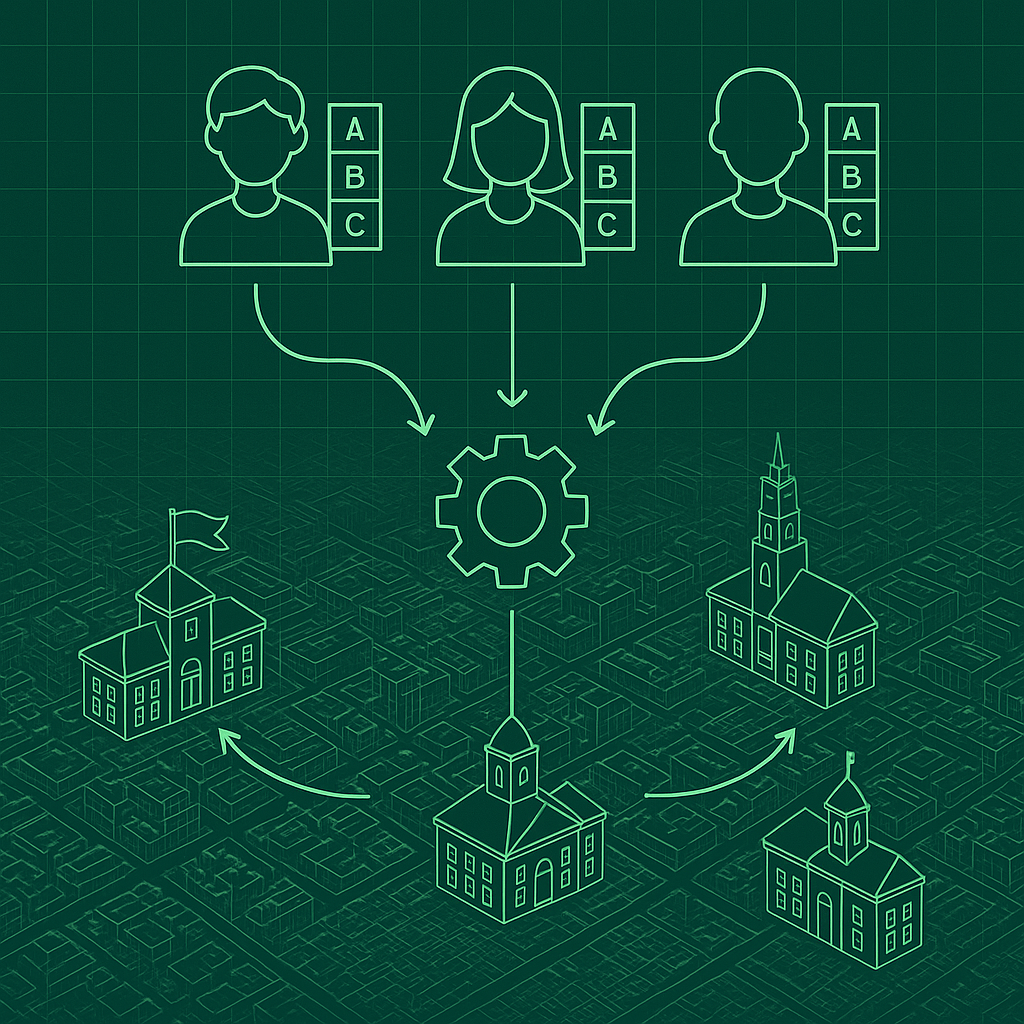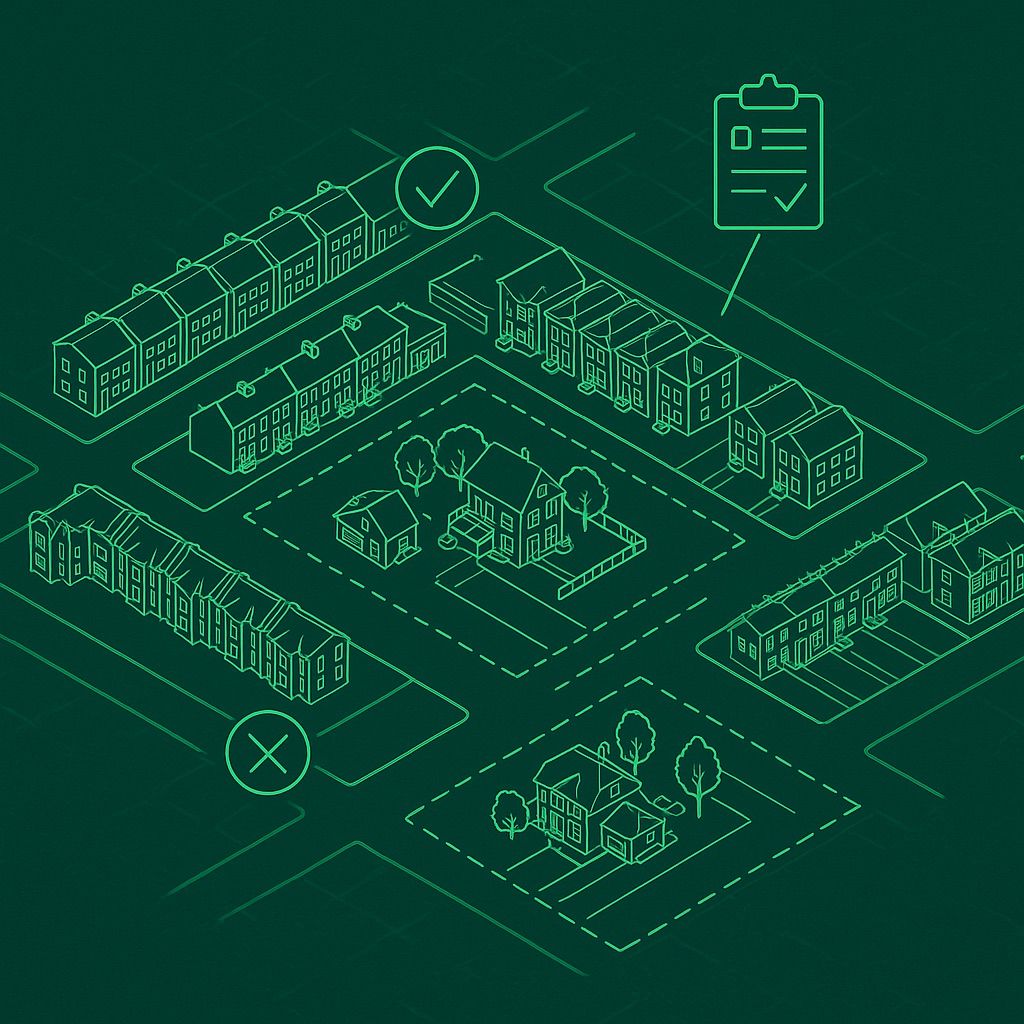
Table of Contents
- 1. Mechanism design in action: success stories
- 2. Emerging applications: new frontiers of mechanism design
- 3. Designing for robustness, not perfection
- 4. Delivering social benefits with better mechanism design
- 5. Authors
The new Labour Government has made mission-driven government, market shaping, and crowding in private investment central themes of its economic agenda. But shaping markets means more than setting broad directions and writing top-level industrial strategies. It requires rewriting the very rules of the game so that private and third-sector actors become allies in advancing public goals, not opponents to be fought. And this is precisely where an underused field of economic thinking, mechanism design, has much to offer.
Mechanism design, sometimes described as reverse game theory, is the study of how to create systems in which multiple actors, each with their own information and goals, can be pushed to produce collectively desirable outcomes. Unlike traditional economic analysis, which predicts the outcome of a given system, mechanism design works backwards: it starts with the desired result and asks: ‘What rules or structures would deliver that outcome?’
Pioneered by economists Leonid Hurwicz, Eric Maskin, and Roger Myerson, who won the 2007 Nobel Prize for it, mechanism design has already shown impact in areas like spectrum allocation, school places, and organ donation. It’s a way to make markets work to achieve social good, not by replacing them but by redesigning them to channel activity more effectively. It is, in short, an essential tool for any government that wants to shape markets instead of simply correcting their failures.
British economists have played a central role in applying these ideas: Ken Binmore helped pioneer the UK’s 3G spectrum auctions under the last Labour Government, and Paul Klemperer developed the ‘Anglo-Dutch’ auction format now used around the world.
As the Government works to rebuild Britain’s economic institutions – housing, energy, transport, care – mechanism design offers a rigorous framework for doing so. It also aligns closely with the Government’s desire to crowd in private action, by creating the right environment and incentives for businesses, communities, and individuals to deliver outcomes that support national missions.
This report will demonstrate how mechanism design can be used by the Government to correct power imbalances: to foster genuine equity, ensure fair distribution of resources, and empower communities, not just correct market failures. It's not a silver bullet, nor does it abdicate public responsibility; rather, it offers a pragmatic way to channel individual and collective action towards shared social goals like fairness and opportunity.
Perhaps most importantly, mechanism design can help unlock political blockages where previous efforts have failed. As we show below, it can do so by generating new policy options that will not be stymied by vested interests.
What follows is a survey of where mechanism design has worked, and where it could be put to work next. We explore how careful institutional design has already shaped incentives in education, planning, digital platforms, and health, and how these same principles might inform UK policy from housing to clinical research.
A government serious about shaping markets needs to shape the mechanisms through which those markets operate. As this article shows, many of society’s most stubborn problems are best tackled not through optimistic exhortation or attempted micromanagement from the centre, but by designing the rules under which different players act – rules that make doing the right thing the easy thing, the desired thing, or the default thing.
Mechanism design in action: success stories
Mechanism design has already delivered tangible improvements in a range of real-world situations. Economists and policymakers designed new ‘games’ – algorithms, auctions, matching processes – that achieved better outcomes even though the underlying human behaviour stayed the same.
Matching pupils to schools

One early success for mechanism design was in US school places. Big school systems in the US often allow families to rank their preferred schools, but designing a fair and effective assignment algorithm is tricky. In the 1990s and early 2000s, cities like New York and Boston faced chaos in their school allocations. Wealthy, better-educated parents sought to game the system. Some parents avoided listing popular schools (for fear of being rejected and ending up with an even worse assignment), and some pupils were left unassigned altogether in the first round. Economists and computer scientists, notably Alvin Roth and colleagues, recognized this as a matching market problem and applied the ‘Gale-Shapley deferred acceptance algorithm’, originally developed for matching residents to hospitals, to these school systems.
The redesigned mechanisms were ‘strategy-proof’, meaning families’ best strategy was simply to give their true preferences, with no need for privileged knowledge or connections. In Boston, for example, the school committee adopted a deferred acceptance algorithm in 2005 to replace an older system that had invited strategic ranking. The result was a fairer process: more students got assigned to one of their top-ranked schools, and no one could gain an advantage by gaming the application.
In New York, a centralized high school match system implemented in 2003 similarly eliminated the nightmare of multiple offers and acceptances. After the change, virtually all 90,000+ incoming high school students were assigned through a single unified process, whereas previously 30,000 had been left unassigned in the first round. These designs also reduced the stress on parents and made the system more transparent. The success of NYC and Boston’s school choice mechanisms has since inspired dozens of other districts to adopt similar market-design based assignment systems. What’s crucial is that the mechanism (the matching algorithm) was designed so that individual incentives (students listing true preferences) produced a collectively better outcome (more students getting schools they want). This is a hallmark of mechanism design in practice.
Allocating the airwaves

Another famous application is the design of spectrum auctions, such as the last Labour Government’s UK 3G spectrum auctions. In the 1990s, the U.S. Federal Communications Commission (FCC) needed a way to allocate licenses for wireless spectrum (used for things like mobile phone networks and TV broadcasts). Previously, publicly owned spectrum resources had been given out by beauty contests or lotteries, which transferred public value to private actors by licensing the spectrum too cheaply. Economists seized the chance to design a better system, crafting auctions that would encourage truthful bidding, mitigate collusion, and allocate licenses to those who valued them most. The result was a series of high-stakes spectrum auctions that raised huge revenues for the government while improving societal benefits, securing effective competition and preventing monopolization.
When the FCC held the first major spectrum auctions in 1994, the results were eye-opening. The auction rules (which drew on game theory insights like the Vickrey-Clarke-Groves mechanism and activity rules to keep bidders honest) led to competitive bidding and fair prices. In just the first four years, over 4,300 licenses were awarded and the auctions raised more than $23 billion, far above initial projections. Over the following decades, the FCC’s spectrum auctions continued to succeed – by 2015, the U.S. Government had more than $100 billion of additional resources thanks to these well-designed auctions. Equally important, the airwaves were put to productive use by companies that won them, fueling the growth of the wireless industry.
Effective design of mechanisms like this ensures that the public captures the full value of these publicly owned resources, securing effective competition by providers of these services to deliver services and preventing monopolisation by a single actor.
The spectrum auction story is often held up as a triumph of mechanism design. By carefully designing the rules – for example, using simultaneous multiple-round bidding so that complementarities between licenses could be expressed, and setting rules against bid withdrawals to prevent strategic manipulation – the FCC achieved what simple ‘highest bidder wins’ or beauty contest methods could not. It aligned private profit motives with the public interest: companies bidding for spectrum were motivated purely by self-interest, yet the outcome was socially beneficial allocation of a public resource and a substantial increase in public revenue. Other countries followed suit, and spectrum auctions around the world have similarly embraced these designs, generating similarly lucrative results globally. In 2020, two of the pioneers of auction design (Paul Milgrom and Robert Wilson) won the Nobel Prize, underscoring how mechanism design ideas have transformed how we allocate critical public resources.
Exchanging kidneys to save lives

Mechanism design has also saved lives. A standout example is the creation of kidney exchange programs. In the early 2000s, thousands of patients faced kidney failure. While loved ones might be willing to donate a kidney, often the donor’s blood type or tissue type wasn’t compatible with their intended recipient. This left many willing donor kidneys unused while patients died on waiting lists. The insight of kidney exchange was that incompatible patient-donor pairs could be matched with other pairs – ‘I’ll give a kidney to your patient if your donor gives one to mine.’ With a large enough pool, one can even form donation chains initiated by an altruistic donor, enabling dozens of transplants.
A commercial market for organs would be widely regarded as repugnant and attract a considerable amount of disgust. There may be many reasons for this, but it is likely that one of the largest is that market mechanisms are often believed to promote undesirable human traits such as greed. Mechanism design shows us that alternative forms of exchange can supercharge altruism, among other virtues, by enabling people to more effectively channel their instincts for social good without having to engage in commercial transactions.
Implementing this required careful mechanism design. Pioneers like Alvin Roth, Tayfun Sönmez, and Utku Ünver formulated the kidney exchange as a matching algorithm problem – essentially a graph problem of finding cycles – and persuaded hospitals and regulators to create clearinghouses for exchange. The rules must ensure ‘incentive-compatibility’: no hospital should have an incentive to hold back a patient or mismatch outside the system); and efficiency: maximize the number of transplants. The result has been nothing short of life-changing. Within a few years of launching kidney exchanges, the system was enabling over a thousand extra transplants per year that would not have happened otherwise. Each of those was a life saved or dramatically improved, achieved by harnessing the ‘coincidence of wants’ in organ donation.
The success of these interventions was not due to people suddenly becoming more altruistic – donors were already altruistic but constrained by biology. It was because the mechanism allowed their generosity to find the right match. The kidney exchange is a clear case of designing a system that turns individual benefits (each patient wants a kidney; each donor wants to help their loved one) into a cooperative solution. In fact, this application was so successful and innovative that it helped earn Alvin Roth a share of the 2012 Nobel Prize in Economics. It’s a powerful reminder that careful design can expand the realm of the possible. What used to be an intractable situation – incompatible donor pairs – was transformed into a solvable matching problem. And importantly, the exchange framework had to be designed to ensure no one is worse off by participating, so that everyone has a good reason to enter the pool. Today, kidney exchanges have become standard in many countries, and similar ideas are being extended to other organs and even to other domains like matching refugee families to communities.
Designing online marketplaces

Some private examples can illustrate the power of mechanism design. If you’ve ever seen an advertisement online or found a ride via Uber, you have seen the effects. Modern online platforms are teeming with algorithmic mechanisms at massive scale to beneficial (or sometimes harmful) societal ends. For example, Google’s advertising system – which accounts for the majority of its $200+ billion annual ad revenue – runs on auctions. Every time you search, advertisers compete in a split-second auction for the ad slots on your results page. The design of these ad auctions was critical to Google’s success. Google famously uses a variant of the Vickrey auction (second-price auction) for search ads, where the highest bidder wins but pays the price of the second-highest bid. This mechanism, along with a quality score system, encourages advertisers to bid their true value and ensures that the outcome is both efficient (ads go to those who value them and will get clicks) and more fair. The mechanism design here had to account for strategic behavior of advertisers, and it does so so well that it operates billions of times a day without manual intervention. It’s no exaggeration to say that mechanism design lies at the heart of the internet’s advertising economy.
Similarly, platforms like Uber rely on mechanism design to balance supply and demand. Uber’s matching algorithm and dynamic pricing (surge pricing) are essentially a mechanism to ensure sufficient drivers to meet demand. When many riders want the service, prices go up, which encourages more drivers to go online and serve the demand. The algorithm also intelligently matches riders to drivers – not just the nearest driver, but an assignment that optimizes overall wait times and efficiency across the network. Uber has found that a slight delay to batch requests can significantly improve matches, reducing everyone’s wait. By bringing supply and demand in line, the platform can achieve very low wait times (often ~2-3 minutes on average) even in busy cities, something that wouldn’t be possible without a pricing and matching mechanism adjusting things in real time. One case study by Uber’s data science team showed that using surge pricing during a crunch event kept average wait times around 2.6 minutes, whereas without price adjustment, waits would have skyrocketed and many requests gone unfulfilled. The key is that riders and drivers each act in their own interest (riders decide if the price is worth it, drivers decide when to work), but the system’s design – the algorithm deciding matches and prices – leads to a well-functioning market that benefits both sides overall (short waits for riders, steady demand and income for drivers).
Beyond Uber and Google, many online platforms are essentially mechanism design experiments. Matching markets like Airbnb (matching travelers with hosts), Upwork (freelancers with clients), or dating apps (matching profiles) all use algorithms to sort, rank, and improve matches. Auction-based exchanges are used for things like online advertising slots on websites, bandwidth allocation in networks, and even Bitcoin mining (the protocol is a mechanism to provide rewards for working). Facebook’s ad marketplace and Google’s ad marketplace are explicitly cited as real-world uses of mechanism design. In each case, the platform succeeds by designing rules that create alignment: e.g. making it in a host’s interest to please guests (reviews systems), or in advertisers’ interest to bid truthfully (second-price auctions), or in drivers’ interest to be available when needed (surge pricing multipliers). The scale is enormous – for instance, Google’s ad auctions process billions of auctions per day and have created a market generating quarter-trillion dollars a year in revenue. Without mechanism design, these complex ecosystems would either descend into chaos or require constant manual control. With mechanism design, they become self-regulating to a large degree, with the ‘invisible hand’ guided by the careful shaping of the market. Of course, what all these private examples omit is the role of the state in ensuring that the outcomes are socially beneficial.
Emerging applications: new frontiers of mechanism design
The successes above are well-known in economics circles. But mechanism design’s potential goes much further. In recent years, innovative policymakers and communities have started applying these ideas to societal problems that, on the surface, have little to do with markets or matching algorithms. What they have in common is a clever alignment of benefits – often by giving people a stake in the outcome or a say in the decision – to solve what would otherwise be stalemates or injustices. Here we explore a few emerging or underappreciated areas where mechanism design principles are inspiring creative solutions: urban redevelopment, housing, and community projects that break logjams by changing the rules of engagement.
Empowering residents for estate renewal

Urban renewal projects – like the redevelopment of social housing estates – often face fierce opposition from residents. In the UK, many post-war estates have fallen into disrepair as councils have been starved of cash. Historically, renewal projects were top-down. Residents often felt powerless, fearing they would be displaced or wouldn’t benefit. Enter a policy that could have been inspired by mechanism design: give the residents the decisive vote. In 2018, the Mayor of London, Sadiq Khan, introduced a rule that any estate renewal involving demolition of social homes must secure majority support from the residents via a ballot in order to get city funding. In other words, the people living there get to approve or veto the redevelopment plans.
This simple rule change had profound effects. It put residents at the centre of decision-making, forcing developers and councils to craft plans attractive enough for London tenants to say ‘yes’. To win a ballot, plans typically must promise new and better homes for existing tenants, no need to move home more than once, more social housing, and community improvements. The mechanism aligns incentives: social landlords now have good reason to incorporate residents’ preferences (since otherwise the project won’t happen), and residents have a voice and thus are more likely to engage constructively rather than reflexively oppose. The requirement of resident buy-in turned adversarial standoffs into a negotiation. As Khan explained, this ensures regeneration ‘happens with residents’ support and engagement,’ not against their will.
The policy has already had real impact. Over 30 estate renewal schemes in London have been approved via resident ballots, often with overwhelming majorities. In one case, residents of an estate in Camden rejected the first plan by a wide margin, citing lack of trust and benefits. The developer went back to the drawing board to address those concerns. By the second vote, residents approved a revised plan – one that gave them larger new homes and more say in design. Only projects that can credibly promise a win-win (better housing for residents and overall social benefits) move forward. This mechanism design approach doesn’t assume blind trust from residents – it creates a structured interaction where the landlord’s best way to get what it wants is by offering the tenants what they want so they’ll vote yes. Early evidence suggests this has improved transparency and fairness in estate renewals across London. Of course, it’s critical to ensure that commitments made to residents are actually delivered. Subject to that and other caveats, it’s a potentially promising template for community-driven development, turning NIMBY dynamics into YIMBY (Yes In My Back Yard) through market shaping.
‘Opt-out’ zoning reform in Houston

How do you add more homes in a city in the face of potential overwhelming backlash from homeowners worried about change? This perennial problem of urban planning – balancing citywide housing needs with local resistance – found a novel solution in Houston, Texas. The city’s planners came up with a way to acknowledge local preferences while still enabling broad change.
Houston is famous for its lack of traditional zoning, but it does regulate ‘minimum lot sizes’ – the smallest plot of land on which you can build a house. In 1998, Houston’s leaders decided to dramatically reduce the minimum lot size in inner-city neighborhoods from the traditional 5,000 square feet to as low as 1,400 square feet. This reform allowed a wave of townhomes to be built, creating more affordable homes and reducing sprawl by enabling more housing on the same land area. However, officials anticipated pushback from some residents who liked their larger lots and suburban feel. So they introduced a clever mechanism: neighbours could collectively opt out of the reform for their specific block.
These ‘special minimum lot’ districts meant that if a qualified majority (generally 2/3 of homeowners on a block) petitioned the city, their block could keep a larger lot size requirement, exempting them from the 1,400 sq ft rule. In effect, the city said: we’ll allow dense development by default, but if your block really doesn’t want it, you have a pathway to preserve the old rules – but only if most of your neighbours are with you. This opt-out principle is almost inverse from the London case: instead of requiring consent to allow development, it required effort and consensus to prevent higher density. And the objectors forego substantial economic benefits in lost potential increased value of their own property if they do decide to prevent more homes on their block.
The impact was striking. Because outright opposition was harder (you had to organize your neighbours and not everyone would agree), relatively few blocks decided to opt out. Only about 16% of eligible blocks citywide chose to establish a large-lot district. The majority of the city quietly embraced the new townhouse development. As a result, Houston saw a boom of over 34,000 townhomes built from 1998 to 2020, substantially increasing housing supply. Neighbourhoods that truly valued their large lots managed to keep them, which meant there was insufficient opposition to the overall reform to block it. Essentially, the policy made reform politically achievable by offering an escape valve for the most sensitive areas. Even those opt-out districts required a collective choice: one lone homeowner couldn’t unilaterally block their neighbours from adding homes. This prevented the classic holdout problem and ensured that only blocks with overwhelming sentiment against townhouses would remain unchanged.
Urban economists have lauded Houston’s approach as a model for land-use reform. It acknowledges local preferences (through the opt-out vote) while still enabling broad change. In mechanism design terms, it created a self-selection mechanism: blocks that genuinely prize the status quo could attain it, while others effectively ‘revealed’ they were okay with more housing by failing to organize an opt-out. The outcome – many new homes, minimal political revolt – suggests the policy aligned incentives well. Homeowners who didn’t mind townhouses didn’t fight, those who deeply cared had a route to preservation, and rents were kept at more affordable levels with a supply of good-quality homes. It’s not a perfect system, but it delivers far more good homes than would have been possible without it. Houston’s lot size reform shows how a policy can be designed to harness local information and preferences to achieve better collective use of land.
Indigenous-led housing development in Senakw (Vancouver)

In Vancouver, Canada, an ambitious housing project called Sen̓áḵw is demonstrating a novel mechanism for urban development by leveraging Indigenous rights and partnerships.The Squamish Nation, a First Nations group, is building 6,000 new homes on a small 10-acre parcel of their reserve land in the heart of Vancouver – a scale and density far beyond what city zoning would typically allow.
How is this possible? Because the project is on sovereign Indigenous land, it is not subject to the City of Vancouver’s planning rules; it falls under Squamish authority. In effect, the Squamish Nation can design its own planning rules and approval process for this project. The Squamish partnered with a developer to plan high-rise towers up to 59 stories, in a city where getting approval for a 20-storey building can be an epic battle. This is a fascinating example of mechanism design in the sense of institutional design: by using a different governance mechanism (tribal jurisdiction) within the city, the project demonstrates the power of the incentives to get built what otherwise would be blocked.
The alignment here works on multiple levels. The Squamish Nation has a strong reason to maximize the value of its land for the benefit of its members – which in this case means building lots of desperately needed rental housing (including affordable units) and generating revenue. The City of Vancouver, facing a housing affordability crisis, indirectly benefits from thousands of new homes. The city has a service agreement to provide utilities, etc., but had no veto over the land use. Some nearby residents in wealthy neighborhoods did object, but they had no formal power to stop a project on tribal land. One might think this would result in a project with no regard for community or sustainability, but in practice the Squamish have every reason to make Sen̓áḵw successful and attractive: it’s a long-term source of income and pride. Indeed, the development includes ample green space, transit integration, and social housing. It’s denser and taller than anything Vancouver’s own policies would allow, yet it’s being delivered with Indigenous leadership and community benefit-sharing.
‘Because the project is on First Nations land, not city land, it’s under Squamish authority... And the Nation has chosen to build bigger, denser and taller than any development on city property would be allowed,’ reported Maclean’s magazine. In mechanism design terms, the Squamish created an alternative mechanism for approvals: one that bypassed the usual local political process that often stalls development. The result is a massive addition of new homes with little use of land, and with profits flowing to an Indigenous community as opposed to private speculators – or simply not being realized at all.
Sen̓áḵw is suggestive of a broader principle: sometimes the way to fix a broken local structure (like city politics that block housing) is to allow supplementary progress through a different system with its own rules. Here, Indigenous land rights provided that different institution. It’s a unique case, obviously not directly replicable everywhere. But it might inspire other creative ‘institutional tweaks’ to align incentives for development.
Elsewhere in Canada and the U.S., other First Nations and tribes are exploring developments on their urban lands. In these zones, where indigenous governments can experiment with pro-growth policies that municipalities struggle to implement. The success of Sen̓áḵw could not only provide much-needed housing and economic uplift for the Squamish people, but also serve as a model of how giving the right stakeholders control – those who stand to gain from building more good homes – can help break gridlocks encountered by old-style urban planning.
Land readjustment

One of the thorniest problems in urban development is assembling land for projects, whether for new infrastructure or to redevelop a challenged area. In many places, a single holdout landowner can stall a project indefinitely, hoping to be bought out at an exorbitant price: the ‘holdout problem’. Those holdouts often mean that a single wealthy landowner can block community progress.
Traditional compulsory purchase by the state can sometimes provoke fierce resistance and extensive litigation. An alternative approach, used successfully in Germany and in parts of Asia, is a mechanism called land readjustment that combines voluntary participation with qualified majority decisions to overcome holdouts. This has been particularly notable in Japan, Taiwan, and South Korea.
In a typical land readjustment project, all landowners in a designated area agree to pool their land together for replotting. The land is reconfigured – some portions are used for new roads, parks, and public facilities, and the rest is subdivided into new building lots. Each landowner gets back a smaller piece of land than they originally had (since some is taken for public use), but now their plot is on a paved street, with utilities and higher potential for building homes. The increase in land value usually makes up for the reduction in size. Crucially, these projects don’t require buying out landowners; instead, everyone becomes a stakeholder in the new plan. But to initiate such a scheme, you need enough neighbors to agree.
Japan has a long history of land readjustment and has built in a qualified majority voting rule for it. For publicly-led projects, interestingly, no formal owner vote is required: the government can proceed if it’s a public work. But for privately initiated land readjustments (say, landowners banding together to upgrade their area), at least 66% of landowners (by number and land area) must consent for the project to move forward. In practice, authorities often seek closer to 80% consent to ensure legitimacy. Once that threshold is reached, however, the remaining holdouts can be legally compelled to go along, with appropriate compensation and guarantees that they’ll receive a plot in the new plan. This supermajority mechanism protects against a small minority derailing improvements that most neighbors want. And because everyone knows that once the threshold is reached the project will proceed, there is no reason to be a stubborn holdout to get an extortionate payout, because you can’t.
The results in Japan have been impressive. By one estimate, land readjustment has developed or redeveloped about 30% of all urban areas in Japan – thousands of projects over the decades. It’s credited with helping cities like Tokyo modernize their infrastructure without mass evictions or endless court battles. In Taiwan, a similar approach is used under the Urban Renewal Act: a proposed redevelopment of a decayed urban block can go ahead if a supermajority of owners (often 75% or 80%) agree, and then the remainder can be bought out at fair value. This was a response to the realization that requiring 100% consensus was unworkable. As one editorial noted, ‘it is often difficult to obtain the 100 percent agreement... required for a renewal project’. Taiwan has since moved towards lower thresholds (75% consent in many cases) to allow needed renewal of dangerous old buildings while still giving residents a strong voice.
What’s clever about the qualified majority rule is that it balances protection for individual homeowners with collective action. No single owner is forced into something with no say – it’s not a top-down imposition – but at the same time, no single owner can hold the majority hostage. It creates a group dynamic: each owner has good reason to join if they believe the project will create value. Conversely, if they refuse but others go ahead, they might be forced in anyway – on possibly less favorable terms than if they had negotiated and accepted. So there’s a built-in incentive to cooperate once a tipping point of support seems likely. Economists would recognize this as a way to solve a coordination problem with a clear rule. The broader lesson is that collective action can be achieved by setting a high but not unanimous bar, while ensuring that the project can proceed if the bar is reached. This mechanism design has enabled urban renewal that preserves some fairness and buy-in – a stark contrast to both the paralysis of requiring everyone’s approval and the bluntness of government eminent domain. As cities around the world grapple with aging infrastructure and the need to rebuild more densely, these land pooling mechanisms with qualified majority consent offer a promising path to progress.
Turning homeowners into YIMBYs: TAMA 38

Perhaps one of the most striking recent policy innovations in housing has come from Tel Aviv. Faced with a need to earthquake-proof older buildings and a severe housing shortage in its cities, Israel launched a program called TAMA 38 in 2005. At its core, TAMA 38 is a supplementary system for urban renewal: it allows private developers to approach owners of old apartment buildings and offer to reinforce or rebuild the building at no cost to the owners, in exchange for the right to add additional apartments to sell. In practice, this can mean demolition of a 3-5 story 1960s building, replaced with a modern 8-story building, or the addition of extra floors on top of a strengthened building. The original owners get improved (or larger) flats in the new structure, and the developer gets the new homes to sell. The genius is that it persuades homeowners to want more construction: it turned NIMBYs into YIMBYs by ensuring their families share the benefits.
Under TAMA 38 (which applied to buildings built before 1980), apartment owners in a building could collectively opt in to let a developer redevelop their property with more density. Before the scheme, 100% of owners in a building had to agree, which meant one holdout neighbor could block progress. The scheme first required 80% consent, but this was later amended to allow two-thirds of owners to agree. This qualified majority rule – similar to the land readjustment concept – ensures that one or two recalcitrant owners can’t block progress if the vast majority are in favor. Essentially, the national government created a parallel path to get housing built: homeowners could reach an agreement with a builder subject to limits, and if they did, the project could go ahead.
The results have been dramatic, especially in high-demand cities like Tel Aviv. In 2010, only 2% of new housing units in Israel came from these ‘urban renewal’ schemes. Today, 37% of all new homes come from TAMA 38 or its sister program Pinui-Binui, and in the Tel Aviv area over half of new construction is via these programs. This is a huge shift. Many thousands of old apartments have been replaced or upgraded, without the need for additional government resources, because the extra market-rate homes finance the whole project. Homeowners who normally resist redevelopment have been eager participants because they get an improvement in their property and reduced maintenance costs. Builders get new projects in key locations where otherwise they couldn’t build homes due to lack of land. And cities quietly get more homes and safer buildings, though care is needed to provide for needed infrastructure. It’s telling that even with some criticism, the program proved so popular that the government extended and expanded it multiple times.
TAMA 38 shows how shaping a market can break the logjam. Normally, if you tell homeowners you want to build near them, they fear disruption, dislike change, and worry about who profits. TAMA 38 essentially let them take the lead: they become the partners in the redevelopment rather than passive obstacles. The benefits they may receive (a free new apartment, no rent while temporarily relocated, and a share of the land value uplift) is aligned with the builder’s desire to build and the public goal of renewing old housing stock. Moreover, by forcing builders to compete to make good proposals to the residents, it avoided using government resources that could improve social welfare in other ways.
It’s not a perfect scheme – it has tended to be used mostly in wealthier areas where sale prices justify the reconstruction, and it arguably has not done enough to improve public amenities. But overall, it added tens of thousands of new homes and significantly improved earthquake safety.
Notably, mechanism design thinking was evident in TAMA 38’s evolution: when initial uptake was slow due to holdouts, the rules were tweaked to allow a qualified majority to bind the rest. When cities worried about losing tax revenues, the government adjusted the policies to make projects viable. It has been a dynamic policy experiment. For our purposes, the takeaway is that TAMA 38 created a new system where homeowners, builders, and the government all had good reasons to cooperate on redevelopment – a stark contrast to the zero-sum fight over development in many cities. By changing the operating system for that part of the economy – who approves projects and who gains – Israel unlocked tens of thousands of new homes that would otherwise never have existed. In effect, they designed a mechanism to persuade NIMBYs to become YIMBYs, without direct subsidies – instead, using the prospective social benefits to persuade.
Designing for robustness, not perfection
Across these diverse examples – from school choice in Boston to skyscrapers on Indigenous land – a common theme emerges: the importance of designing systems that work despite (perhaps even because of) groups pursuing their own interests. Mechanism design does not assume saints or perfectly rational omniscient actors; quite the opposite. It acknowledges that privileged parents might strategize, bidders might collude, neighbours might resist change, or officials might be swayed by vocal and unrepresentative groups.
Instead of giving up, mechanism design asks: what system can we put in place so that by people choosing what they consider the best options, the outcome is better for society? Rather than try to tell voters what they ought to think, we can empower citizens to create better social outcomes of their own accord.
This often means building redundancy and feedback into the rules. For example, the scheme used in the US for school places (the ‘deferred acceptance algorithm’) is robust to families trying to ‘game’ the system. Truth-telling is the best strategy for the families themselves. The FCC auction rules were crafted to be robust against collusion and predatory bidding. Houston’s opt-out was robust against knee-jerk opposition because it required collective and costly action, filtering out frivolous objections. TAMA 38 was robust against homeowner inertia by making an attractive offer of better housing and later robust against partial holdouts by allowing supermajority to bring the dissenters along, subject to safeguards. These systems don’t count on everyone ‘doing the right thing’ – they strive to make the right thing the path of least resistance.
Many successful systems also provide contestability: ensuring there are parallel, rival processes so that each must keep improving to avoid being displaced. True redundancy comes from having multiple routes to the same objective that are forced to outperform one another over time, as we see in the Houston and TAMA 38 systems.
It’s also notable how many of these mechanism design solutions turn conflicts into more like consensual negotiations or collective choices with shared benefits, rather than winner-takes-all fights. A resident ballot forces the estate renewal to persuade the residents by making a better proposal. Land pooling literally shares the improvement with holdouts by giving them a stake in the new plan, rather than evicting them. Auctioning spectrum replaced political pull and insider gaming (beauty contests) with transparent bids: if a company wants a license, they pay the public for it – ensuring that profit motives deliver social improvements. Economists would say that mechanism design can factor in the externalities so that the private decision-maker feels (or at least approximates) the true social costs or benefits of their actions. That’s why these subtler approaches can achieve more than moral appeals or brute force alone.
As many of the examples above illustrate, mechanism design can also provide extremely powerful ideas to unlock political gridlock, by providing another way forward when other options have been blocked by vested interests. Houston would have found densification far harder without its ‘opt-out’ mechanism. Japan has managed to achieve feats of redevelopment with land readjustment that have eluded England and other European countries for centuries.
None of this is to say mechanism design is a silver bullet. Designing a good mechanism is hard. It requires understanding the details of context, the motivations of participants, and often some trial and error. A poorly designed mechanism can backfire. For instance, you might encourage the wrong behaviour, as happened with some carbon credit schemes; or if a matching algorithm isn’t strategy-proof, people will find ways to game it.
And even a well-designed mechanism can have distributional impacts that need to be managed. TAMA 38 favoured certain areas over others; spectrum auctions raised prices for telecom companies which they passed to consumers. So, mechanism design is not a utopian fix that automatically yields ‘win-win’ outcomes for everyone. Rather, it’s a framework for innovation in policy and institutional design to deliver, one that has proven its worth in many domains and holds great promise in others. It provides an additional tool as we aim to improve state capacity.
We live in complex societies where relying purely on goodwill or simple central planning is prone to failure. Mechanism design offers a pragmatic optimism: with the right rules and structure of benefits, we can get people as they are to generate better social outcomes. It is essentially about structural optimism – believing that by changing the game, we can change the results, even if we don’t change the players. In a world facing big challenges – climate change, inequality, technological disruption – that perspective is incredibly powerful. It tells us we don’t necessarily have to rely on enlightenment or consensus; sometimes, we can build cooperation and foresight into the systems we create.
In the final section, we look ahead to some future frontiers where mechanism design could make a meaningful difference. These are areas where problems currently seem politically intractable or poorly managed. But by applying the same kind of thinking as above, we might unlock solutions that today seem out of reach. The list is by no means exhaustive. But we seek to give a sense of the potential of this approach.
Delivering social benefits with better mechanism design
What other tough social challenges might benefit from a mechanism design lens? Here are six areas where applying these principles could yield transformative ideas in the coming years. Each represents a domain where aligning incentives and creating smarter rules might turn gridlock into win-win progress:
1. Improved state capacity: many of the problems faced by UK governments can be traced back to badly structured incentives. Civil servants have strong career reasons to minimise controversy, maintain consensus and move jobs frequently. They have little reason to become experts in a single sector, still less to deliver deep, potentially traumatic systemic improvements at pace. This is a classic case of Cardwell’s law: institutions that once thrived decay when they face no external contest or existential threat, so deliberate re‑engineering is vital to keep capability from sliding. Ministers have reasons to push for media coverage and score short-term goals before they are reshuffled rather than create substantial long-run improvements. All of these things could be improved. Some governments in other places do this better.
2. Urban congestion charging: Traffic congestion in big cities is a textbook case of a badly structured market delivering socially harmful outcomes. Each driver’s decision to drive at rush hour imposes delays on everyone else. Congestion charging can fix that by charging fees for driving in crowded areas at busy times, making wealthy urban drivers internalize the cost they impose. London’s congestion charge, implemented in 2003, reduced traffic entering the city centre by 18% and cut delays (congestion) by 30% immediately. Many cities are now following suit (Stockholm, Singapore, New York). Beyond just fees, one can design the scheme to use revenues for public transit improvements, turning drivers into supporters if they see better alternatives. Mechanism design here transforms a socially damaging position (gridlock) into a more beneficial one (flowing traffic and faster buses) by ensuring a fair price for the scarce road space. And it could be further employed to ensure that political backlash is minimal – for example, by only imposing it initially on new cars of given types sold after a certain date. The UK is likely to find congestion charging increasingly necessary in cities beyond London as self-driving vehicles increase the willingness to use roads even to the point that congestion pushes average speeds down below walking pace.
3. Building more homes: With the exception of estate renewal, land readjustment is not done today in the UK. Development corporations could theoretically do land readjustment using their compulsory purchase powers, although it would likely be hard to persuade landowners without Japanese-style rules to avoid fiscal friction. And milder versions could be imagined. Local government in South Tottenham created rules to allow families in overcrowded homes to add more bedrooms in additional storeys, designed in sympathy with the existing place. Because each family benefits, the scheme is much more positively received than where a developer demolishes several suburban houses to build a block of flats among the remaining houses. We could envisage further versions to enable gentle, high quality addition of homes in existing settlements – perhaps like the proposals in South Tottenham; with opt-ins like the ‘street votes’ proposal, for which the enabling legislation has already been passed; or with opt-outs as in Houston, above.
4. Drug approval and supporting innovation: Bringing a new treatment to market is costly and risky. Current systems lead to underinvestment in certain areas, like treatments for diseases prevalent in low and middle income countries, because profits are low. We could design advanced market commitments or prize mechanisms to encourage drug development where we need it. For example, an advance market commitment promised a sizable purchase for a successful vaccine for pneumococcal vaccines in developing countries, spurring firms to invest. Another mechanism is the US FDA’s priority review voucher program: develop a drug for a neglected disease, and you earn a voucher that can be sold or traded to get a priority review for another drug. This effectively shapes a market to encourage private firms to tackle neglected research. More broadly, we could imagine a market for pharmaceutical R&D outcomes – governments pooling funds to pay for desired health innovations, and companies competing in a tournament. Such mechanisms align private motivations with public health goals.
5. Wildlife conservation schemes: Conservation often pits local communities against global environmental goals. Farmers may clear forest for agriculture, but the world loses biodiversity. Mechanism design can help by rewarding conservation outcomes. This is, in part, the goal of the new Environmental Delivery Plans in the Government’s Planning and Infrastructure Bill. As another example, Namibia’s community conservancies and Zimbabwe’s CAMPFIRE program allowed communities to benefit from wildlife tourism and hunting licenses, and in return wildlife numbers rebounded markedly in those areas. Shaping markets around helping wildlife can be mechanism design in service of nature.
6. Medical trial recruitment and matching: Clinical trials for new treatments often struggle to find enough eligible patients, while patients with rare diseases struggle to find trials. There’s a mismatch in information and rewards. A potential mechanism design solution is a trial matching platform – a centralized system where patients (or their doctors) submit profiles and available trials compete or bid to recruit them. We could allocate some form of priority or compensation to patients for joining trials, especially risky Phase I/II trials. Another approach is adaptive trial marketplaces: if patients have certain biomarkers, trials that need those biomarkers will actively seek them. By making trial enrollment more of a matching market, we could significantly speed up research. And incentive-aligning contracts for pharmaceutical companies could encourage sharing patients in platform trials (where multiple drugs are tested in a single master protocol), benefiting all. Ensuring that trial slots and patient participation are efficiently matched could reduce delays and ethical issues: patients would be more likely to get a treatment that helps them or at least a trial that they value being in. Proper checks would be needed for safety and equity. The existing goals of the participants are that patients want the best care and researchers want patients. Harnessing those goals could increase the pool of trial participants and accelerate medical breakthroughs.
None of this is to say mechanism design is a silver bullet. Crafting good mechanisms takes deep understanding of context, costs, social benefits, and political blockers. Poorly designed rules can fail to work at all or have bad distributional impacts. But for a government committed to mission-driven policy, crowding in private initiative, and shaping markets rather than simply reacting to them, mechanism design is a vital part of the toolkit. It offers a way to engineer public legitimacy, fairness, and private participation into the structure of institutions themselves, not as an afterthought. When done well, it can turn adversarial negotiations into mutually beneficial arrangements – and convert passive stakeholders into active supporters.
The promise of mechanism design is not utopian but constructive. It gives governments a way to unlock stalled systems – housing, infrastructure, climate investment – by setting rules that harness participants’ own actions to achieve collective outcomes. It provides the scaffolding for a broad, modern state that doesn’t limit itself to taxes alone, but which designs economic systems where the right actions happen at scale, by design, not chance. As Britain looks to rebuild its institutions and renew its economic dynamism, it will need more than funding and ambition. It will need precisely this kind of quiet ingenuity: shaping the games so that the players help build the future we want.
For more information about our initiative, partnerships, or support, get in touch with us at:
[email protected]For more information about our initiative, partnerships, or support, get in touch with us at:
[email protected]